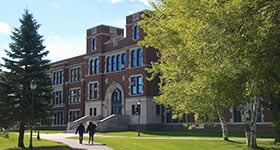In any school district, superintendents and district administrators have critical roles with enormous scopes. They set the priorities and standards for the entire district — decisions that affect everyone in the school community, from students to parents to local businesses. The district’s operations begin with these roles and trickle down to everyone else.
These responsibilities include the establishment, implementation and evaluation of systems and policies throughout the district, as well as the development of instructional leadership and best practices. Given the sweeping scope of their role, aspiring superintendents or district administrators must possess an equally extensive knowledge base with an understanding of many areas and their intricate connections.
The Education Specialist (Ed.S.) in Educational Administration — Superintendent/District Administrator online program from the University of Wisconsin-Superior (UW-Superior) prepares graduates for the rigorous requirements of leading a school district. This Ed.S. program offers an opportunity to learn from faculty with real-world educator experience and leading-edge coursework that adapts to meet evolving administrative challenges. To accommodate the needs of working educators, the program is also offered in a flexible, accelerated online format.
Graduates will gain specialized knowledge of district administration and superintendency and the necessary skills for those areas. This expertise includes hiring practices, policy writing, professional development, ethics and informed decision-making, among other crucial skills.
Let’s look at some job responsibilities for superintendents and district administrators. While many parts of their roles overlap, there are also differences between the two jobs.
Responsibilities of a Superintendent
The superintendent is the leader at the top of a school district, similar a principal operates within a specific school. Typically, the superintendent is supervised by a board of education — typically an elected board — responsible for keeping a superintendent accountable and evaluating their effectiveness. Naturally, superintendents who can foster a healthy working relationship with their school board are more effective than those who cannot.
Superintendents are responsible for informing the board of important events and happenings in the district and delivering recommendations about different levels of operations, as the education resource ThoughtCo outlines. For school board meetings, superintendents usually create the agenda. Superintendents attend and partake in all school board meetings but do not vote on agenda items.
One of the broadest but most telling ways to think about the role of a superintendent is as the “face of the district,” as explained by ThoughtCo. While they oversee many of the day-to-day operations of a district, they are also essentially its primary representative. Relationships between the school district and other parties run through the superintendent, so these professionals must effectively cultivate connections that improve conditions for all community members. These relationships run the gamut, from meeting parents and guardians of students to community members who do not have direct ties to schools such as businesses, senior citizen groups and others.
For superintendents in large media markets, the “face of the district” responsibility extends further, as those leaders regularly appear on the news and in the media as advocates for their district. Given the political nature of public schools and funding, superintendents must also lobby on behalf of their districts to foster policies and legislation that benefit schools.
Of course, superintendents play a role in the day-to-day operations of their districts as well. They spearhead the annual budgets and ensure the allocation of funds to the necessary areas. Funding is one of the superintendent’s most important and difficult responsibilities due to funding fluctuations, and laying off employees or cutting programs are not easy choices. Their budgetary purview also includes school transportation like buses, building improvements and many more issues.
Responsibilities of a District Administrator
Typically, district administrators have a lot of responsibility overlap with superintendents. They serve a level below the superintendent from a hierarchy perspective and are often responsible for administering or directly monitoring activity daily, as explained by the career resource Climb the Ladder. They implement new programs and work with other administrators and staff throughout the district to ensure adherence to policies. They also review a large amount of students’ data to identify potential issues.
Budgets are also a major responsibility for district administrators. They are responsible for establishing budgetary goals that can still meet the district’s needs while also reviewing requests from individual schools. While superintendents carry a lot of responsibility as district representatives, district administrators often carry out the important day-to-day activities in any district.
UW-Superior’s program does not give graduates all the required certifications they need but “provides a path to administrator licensure. It is designed to increase competencies and satisfy certification requirements to prepare for new roles with increased responsibilities.” Graduates of the program will be eligible for the Wisconsin K-12 superintendent license.
For those ready to lead and support the operations of a school district, UW-Superior’s online Ed.S. in Educational Administration – Superintendent/District Administrator program can set you on the path to a rewarding administrative career.
Learn more about UW-Superior’s online Ed.S. in Educational Administration – Superintendent/District Administrator program.


